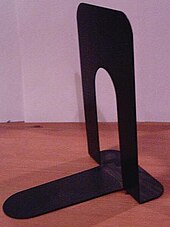Bookend
In today's world, Bookend is a topic that has captured the attention of millions of people around the planet. Since its emergence, Bookend has caused a great impact in various areas, generating heated debates and conflicting opinions. Its relevance is undeniable, since its influence extends to fields as diverse as politics, technology, culture, science and society in general. Bookend has left a deep mark on recent history, challenging established paradigms and offering new perspectives on the challenges of the contemporary world. In this article, we will analyze the many facets of Bookend and explore its meaning in the current context.
This article needs additional citations for verification. (March 2014) |



A bookend is an object tall, sturdy, and heavy enough that is placed at either end of a row of upright books to support or buttress them. Heavy bookends—made of wood, bronze, marble, and even large geodes—have been used in libraries, stores, and homes for centuries; the simple sheetmetal bookend (originally patented in 1877 by William Stebbins Barnard) uses the weight of the books standing on its foot to clamp the bookend's tall brace against the last book's back; in libraries, simple metal brackets are often used to support the end of a row of books. Elaborate and decorative bookends are common as elements in home decor.
The word "bookend" is also used metaphorically to refer to any pair of items which frame and define a significant or noteworthy event or place. For example, regarding the practice in the United States whereby Memorial Day and Labor Day demarcate the traditional beginning and end of summer, those two holidays could be referred to as bookends. Bookends are usually made of metal and plastic.
See also
- Bookend terrace, a bookend effect in the design of terraced houses.